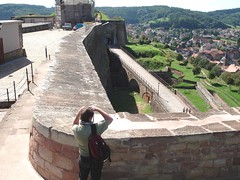
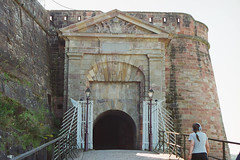
The citadel was truly amazing.It was the site of one of the greatest sieges of the 1870-1871 war. On 19 July 1870, France declared war to Prussia. The Prussian troops entered the French territory and attacked the citadel of Bitche on 8 August 1870. The defenders of the citadel, led by Commandant Teyssier, repulsed the Prussians, who laid siege to the fortress. Both the citadel and the city of Bitche were repeatedly bombarded. On several instances, Prussian emissaries required the surrender of the French troops. Teyssier unshakeably answered he would leave the citadel only on the orders of the French government. The siege lasted until March 1871 when Napoleon surrendered his sword to the prussian forces. By the time that occured 280,000 French troops and 140,000 German troops lay dead. On entering the citadel you get a pair of head phones which leads you through a dozen different areas within the fortress. An ongoing movie documents the entire battle as you go from room to room. Fascinating stuff.
On the flank of the citadel were Jardin pour La Paix / Garden for Peace. The aim of the "Gardens without Borders" project is to revive the shared garden history and garden culture in the crossborder "Saar-Lor-Lux" region.
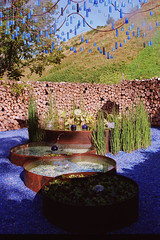
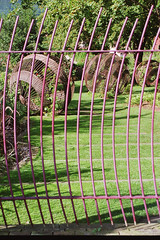
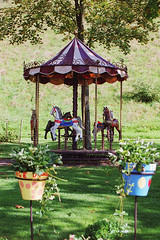
To date, the following gardens have been opened to the public:
Merzig (D): Sensual Garden
Perl-Borg (D): Roman Gardens at Villa Borg
Perl (D): Baroque Garden Terraces in von Nell Park
Perl-Nennig (D): Renaissance Garden (Schloss Berg)
Mettlach-Tünsdorf (D): Farmhouse Garden
Weiskirchen (D): Perennial Garden in the spa park
Wadern-Dagstuhl (D): Manor House Garden
Merzig (D): Rose Path along the embankment of the River Saar
Konz (D): Farmhouse Garden at the Roscheider Hof
Schengen (L): Baroque Garden and Herb Garden (monastery)
Bitche (F): Garden of Peace
Pange (F): Garden of Awakening
We left there and headed west to Lembach were we stayed over night in one of the old fachwerk hotels of the area. The next morning we went a few kilometers out of town to the Four à Chaux to take a look at the Maginot Line. The Maginot Line was a powerful line of defense which stretched from Switzerland to the Ardennes in the North, and from the Alps to the Mediterranean in the South. It was a vast, dynamic, state-of-the-art, ultra-modern defensive system. Most of its components were underground, where interconnecting tunnels stretched for kilometers, and where, beneath the earth, thousands of men slept, trained, watched, and waited for a war that never came. The massive 70 tonne gun turrets could be raised or lowered by either electric motors or by a one person crank handle. These turrets would lift out of the mountain tops like gigantic steel mushrooms, deliver their bombardment and drop back into the ground when under threat from enemy bombardment. Each cannon was on a chain driven automatic loading system which could fire 100 shells per minute.
The line was built between 1929-1939 over some 700km's as a defence barrier between France and Germany. In the end, the Maginot Line was considered by many to be a failure. It was powerful and supposedly impregnable, yet it failed to save France from a humiliating defeat by the German army in 1940 when its supply lines were cut off from behind. Remarkably despite the incredible fortifications and elaborate tunnels the Germans only took 12 months to take it over after the second world war began. Men spent 3 month tours of duty down in the tunnels and trained at the French naval submarine school to make sure they would with stand the conditions imposed by the claustrophobic living environs. They slept 3 men to a bunk in rotating 8 hour shifts. It really was a remarkable insight into one of mans most unique constructions. Well worth the look. Daunting in its magnitude and saddening in its loss of life. The tour took 2.5 hours and the temperature was a steady 13 deg through out. A chilly life but safe from the bombs and bullets outside.
No comments:
Post a Comment